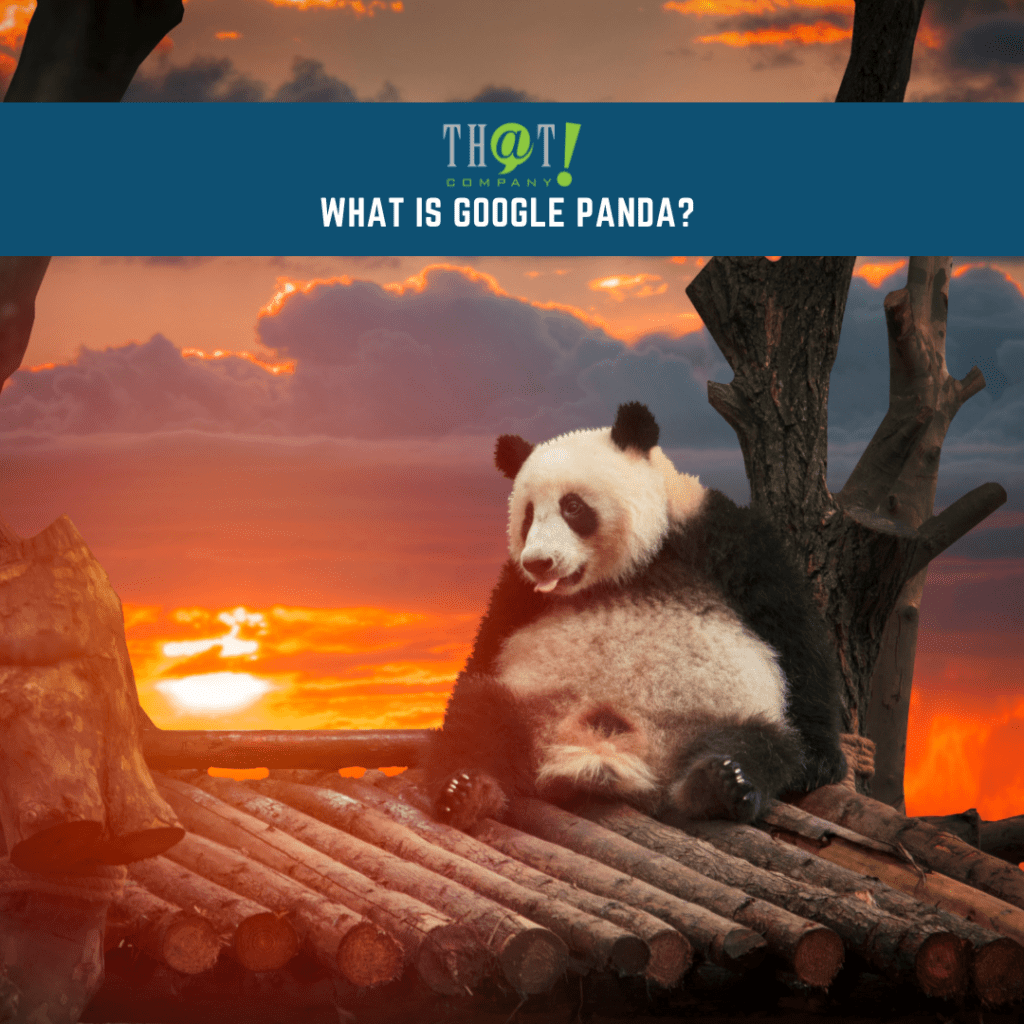
Google Panda was born out of an attempt to put quality content creators and high-quality content above the rest. Picture this, it’s 2010, and Google search results are nothing like they are today. The highest-ranking sites are “content farms” that put out thousands of new articles and pages of content (The majority of these pieces are not created with quality in mind). Google’s algorithm rewards quantity and constant churning out of content, and the real, high-value, quality content is being shoved below the mass-produced material.
News articles soon noted the decline of Google results and users cried out for change. Google saw the problem, heard the complaints, and created a solution. Enter Google Panda, an update that would answer the problem of “content farms” and other sites pushing out mass-produced, low-grade, low-value content. No longer would these sites be allowed to rank high on their
SERPs through their thin content and black-hat SEO.
Google further emphasized the importance of creating pages that satisfy the needs of the user by providing valuable answers, in-depth information, and original content. This content “sieve” received separate updates from its inception in 2011 until 2015. In 2016
Google integrated Panda as the main component of its algorithm to help them improve in identifying ranking signals and site quality.
About Google Panda

As mentioned earlier, Google penalizes sites that rank high while dishing out content that isn’t substantial (thin content). Some examples of content that is frowned upon are duplicated pages, unoriginal content (content that offers no unique value compared to others) or surface-level content (content that offers limited information), and pages that are obviously ad stuffing (more ad than actual content) or word stuffing (pages that stretch word counts by overcomplicating simple explanations, unnecessarily repeating phrases, etc.)
Sites participating in the above practices were and are continually being punished, giving rise to higher-quality sites. Google continues to prioritize high-value, informative, user-oriented content and wants these to be displayed on its results pages. Interestingly, this is a huge reason for the rise of
private label SEO services – agencies needed knowledgeable teams to get their clients out of trouble and on the right track.
White label branding services, in turn, helped companies that were on the wrong path recover their reputation after ranking hits.
What Did Panda Do?
If you want to keep in line with Google’s emphasis on high-value content and ensure the future of your website, you may be wondering exactly how to produce material with the Panda seal of approval.
Below are some guidelines:
- Create content for the user. Your pages should be constructed with the goal of providing help to searchers. Keywords can only get you so far, and prioritizing the engine over the person goes against the type of SERPs Google is trying to build. Take your ideal client avatar with a specific personality who is at a specific stage in the purchase journey and create content for that person.
- Eliminate duplicates. Even though duplicate content is not a high priority for Panda, it’s a good practice to remove unnecessary duplication on your site or across your domains. If you must have duplicates (like landing pages for ads), use robots.txt so bots won’t crawl them. Then focus on creating original, unique and transformative content that consistently adds value to readers.
- Strategic ad placement. Make sure your ads are proportional to your content. Don’t overstuff your pages with ads.
Pro Tip: Google Webmaster tools is a great resource for optimizing your website not only for the engine but more importantly with user experience in mind.
[bctt tweet=”Learn about “what is Google Panda”, an update that would answer the problem of “content farms” and other sites pushing out mass-produced, low-grade, low-value content.” username=”ThatCompanycom”]
Recovering from a Panda Hit

While Panda penalty is the more well-known name, Google has come to term it as the “Quality Algorithm” that assesses the quality of your website as a whole. Getting hit by the algorithm has site-wide consequences and as such, you should know how to tell if you’ve been “penalized” and how you can recover from it.
Here is what to look out for if you suspect you’ve been hit by Panda:
- Ranking difficulties. Google gives every site a quality score. They decide this based on user experience, actual quality checks, and dozens of static elements. They lower the quality score of penalized sites or sites that do not meet their content quality standards. This makes it more challenging to rank regardless of backlinks and other efforts. While you can still rank for keywords, your ranking takes a big hit. You can confirm traffic and keyword drops through Google Analytics.
- Traffic drops. You will notice the traffic to your site will decrease significantly and/or sometimes gradually and then stabilize. This is to be expected because losing rank usually equates to lost clicks.
- Google algorithm updates. It’s been observed in the past that rankings drop after certain Google updates. If you experience this, evaluate your site and determine if it was Panda.
Note: Because Google does not view Panda as a penalty, these are not manual actions you can look up in your
Webmaster Tools.
According to Google, this is how you
recover after being hit by Panda/other penalties (although they no longer call panda a penalty):
No site is completely unsalvageable, however, recoveries can vary between 72 hours to several months before resolving. How long recovery takes depends on a few factors. First, how severe is the problem? Are you experiencing a minor ranking drop or are you not ranking at all after being on top? Are you maybe even De-Indexed? Second, look at the speed at which you can identify and resolve your site issues. (The faster, the better.) Third, how long it takes Google to process your request for reconsideration will help you to understand your chances of recovery.
Examine Your Site

Google Panda is one of two of the most common Google penalties, Google Penguin being the other one. Getting hit by Panda can have severe and potentially long-lasting impacts on your site. Even though the latest stand alone roll-out of Google Panda was in 2016, your site can still get caught by it because that roll-out made Panda part of the core Google ranking algorithm.
The immediate course of action is to examine the aforementioned symptoms that your site is suffering. Next, you’ll want to resolve these as quickly as you can. The longer you wait to resolve issues, the higher the likelihood of dropping further in rankings, especially if a new Google update comes along. Resolving can be as simple as following the guidelines for writing high-quality content listed above. When you start following Google’s advice, you can start seeing improvements as early as the very next Google update or algorithm refresh.
Note: You won’t need the “penalty cure” if you practice “penalty prevention”. Evaluate your site based on the parameters of thin or low-quality
content. If your site meets any of them, act immediately to prevent the “Panda hammer”.
Final Thoughts / Is It Still Relevant in 2022?
Google’s commitment to quality ensures that bad SEO practices are punished and best practices are rewarded. Google values content that is created to satisfy the needs of its searchers. One of their goals is to see less subpar content or sites using manipulative ranking techniques on their search engine results pages. A big step towards this goal is Google Panda and the quality control that websites are subject to.
Is it still relevant in 2022? While you won’t necessarily see big flashy headlines about “Google Panda” as much anymore, since Google has built this kind of algorithm updates into their core updates, Google Panda is alive and well. This is an important reminder that quality is just as important today as when Google Panda was first released back in 2011.
Don’t wait for Panda or other Google updates to penalize you. Take proactive action to increase the value you bring to results pages and ultimately be a trusted resource to those searchers looking for valuable, high-quality content.
 Google Panda was born out of an attempt to put quality content creators and high-quality content above the rest. Picture this, it’s 2010, and Google search results are nothing like they are today. The highest-ranking sites are “content farms” that put out thousands of new articles and pages of content (The majority of these pieces are not created with quality in mind). Google’s algorithm rewards quantity and constant churning out of content, and the real, high-value, quality content is being shoved below the mass-produced material.
News articles soon noted the decline of Google results and users cried out for change. Google saw the problem, heard the complaints, and created a solution. Enter Google Panda, an update that would answer the problem of “content farms” and other sites pushing out mass-produced, low-grade, low-value content. No longer would these sites be allowed to rank high on their SERPs through their thin content and black-hat SEO.
Google further emphasized the importance of creating pages that satisfy the needs of the user by providing valuable answers, in-depth information, and original content. This content “sieve” received separate updates from its inception in 2011 until 2015. In 2016 Google integrated Panda as the main component of its algorithm to help them improve in identifying ranking signals and site quality.
Google Panda was born out of an attempt to put quality content creators and high-quality content above the rest. Picture this, it’s 2010, and Google search results are nothing like they are today. The highest-ranking sites are “content farms” that put out thousands of new articles and pages of content (The majority of these pieces are not created with quality in mind). Google’s algorithm rewards quantity and constant churning out of content, and the real, high-value, quality content is being shoved below the mass-produced material.
News articles soon noted the decline of Google results and users cried out for change. Google saw the problem, heard the complaints, and created a solution. Enter Google Panda, an update that would answer the problem of “content farms” and other sites pushing out mass-produced, low-grade, low-value content. No longer would these sites be allowed to rank high on their SERPs through their thin content and black-hat SEO.
Google further emphasized the importance of creating pages that satisfy the needs of the user by providing valuable answers, in-depth information, and original content. This content “sieve” received separate updates from its inception in 2011 until 2015. In 2016 Google integrated Panda as the main component of its algorithm to help them improve in identifying ranking signals and site quality.
 As mentioned earlier, Google penalizes sites that rank high while dishing out content that isn’t substantial (thin content). Some examples of content that is frowned upon are duplicated pages, unoriginal content (content that offers no unique value compared to others) or surface-level content (content that offers limited information), and pages that are obviously ad stuffing (more ad than actual content) or word stuffing (pages that stretch word counts by overcomplicating simple explanations, unnecessarily repeating phrases, etc.)
Sites participating in the above practices were and are continually being punished, giving rise to higher-quality sites. Google continues to prioritize high-value, informative, user-oriented content and wants these to be displayed on its results pages. Interestingly, this is a huge reason for the rise of private label SEO services – agencies needed knowledgeable teams to get their clients out of trouble and on the right track. White label branding services, in turn, helped companies that were on the wrong path recover their reputation after ranking hits.
As mentioned earlier, Google penalizes sites that rank high while dishing out content that isn’t substantial (thin content). Some examples of content that is frowned upon are duplicated pages, unoriginal content (content that offers no unique value compared to others) or surface-level content (content that offers limited information), and pages that are obviously ad stuffing (more ad than actual content) or word stuffing (pages that stretch word counts by overcomplicating simple explanations, unnecessarily repeating phrases, etc.)
Sites participating in the above practices were and are continually being punished, giving rise to higher-quality sites. Google continues to prioritize high-value, informative, user-oriented content and wants these to be displayed on its results pages. Interestingly, this is a huge reason for the rise of private label SEO services – agencies needed knowledgeable teams to get their clients out of trouble and on the right track. White label branding services, in turn, helped companies that were on the wrong path recover their reputation after ranking hits.
 While Panda penalty is the more well-known name, Google has come to term it as the “Quality Algorithm” that assesses the quality of your website as a whole. Getting hit by the algorithm has site-wide consequences and as such, you should know how to tell if you’ve been “penalized” and how you can recover from it.
Here is what to look out for if you suspect you’ve been hit by Panda:
While Panda penalty is the more well-known name, Google has come to term it as the “Quality Algorithm” that assesses the quality of your website as a whole. Getting hit by the algorithm has site-wide consequences and as such, you should know how to tell if you’ve been “penalized” and how you can recover from it.
Here is what to look out for if you suspect you’ve been hit by Panda:
 Google Panda is one of two of the most common Google penalties, Google Penguin being the other one. Getting hit by Panda can have severe and potentially long-lasting impacts on your site. Even though the latest stand alone roll-out of Google Panda was in 2016, your site can still get caught by it because that roll-out made Panda part of the core Google ranking algorithm.
The immediate course of action is to examine the aforementioned symptoms that your site is suffering. Next, you’ll want to resolve these as quickly as you can. The longer you wait to resolve issues, the higher the likelihood of dropping further in rankings, especially if a new Google update comes along. Resolving can be as simple as following the guidelines for writing high-quality content listed above. When you start following Google’s advice, you can start seeing improvements as early as the very next Google update or algorithm refresh.
Note: You won’t need the “penalty cure” if you practice “penalty prevention”. Evaluate your site based on the parameters of thin or low-quality content. If your site meets any of them, act immediately to prevent the “Panda hammer”.
Google Panda is one of two of the most common Google penalties, Google Penguin being the other one. Getting hit by Panda can have severe and potentially long-lasting impacts on your site. Even though the latest stand alone roll-out of Google Panda was in 2016, your site can still get caught by it because that roll-out made Panda part of the core Google ranking algorithm.
The immediate course of action is to examine the aforementioned symptoms that your site is suffering. Next, you’ll want to resolve these as quickly as you can. The longer you wait to resolve issues, the higher the likelihood of dropping further in rankings, especially if a new Google update comes along. Resolving can be as simple as following the guidelines for writing high-quality content listed above. When you start following Google’s advice, you can start seeing improvements as early as the very next Google update or algorithm refresh.
Note: You won’t need the “penalty cure” if you practice “penalty prevention”. Evaluate your site based on the parameters of thin or low-quality content. If your site meets any of them, act immediately to prevent the “Panda hammer”.






























